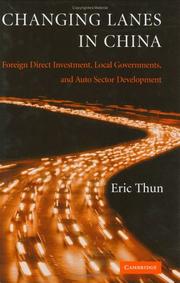| Listing 1 - 4 of 4 |
Sort by
|

ISBN: 9780511610738 9780521843829 9780521724098 0511137192 9780511137198 0511610734 0521843820 9786610431434 6610431434 1107151821 1280431431 0511183453 0511201419 0511308906 0511135025 0521724090 Year: 2006 Publisher: Cambridge ; New York : Cambridge University Press,
Abstract | Keywords | Export | Availability | Bookmark
 Loading...
Loading...Choose an application
- Reference Manager
- EndNote
- RefWorks (Direct export to RefWorks)
This book addresses two of the most important trends in political economy during the last two decades - globalization and decentralization - in the context of the world's most rapidly growing economic power, China. The intent is to provide a better understanding of how local political and economic institutions shape the ability of Chinese state-owned firms to utilize foreign direct investment (FDI) to remake themselves in the transition from inefficient and technologically backward firms into powerful national champions. In a global economy, the author argues, local governments are increasingly the agents of industrial transformation at the level of the firm. Local institutions are durable over time, and they have important economic consequences. Through an analysis of five Chinese regions, the treatment seeks to specify the opportunities and constraints that alternative institutional structures create, how they change over time, and ultimately, how they prepare Chinese firms for the challenge of global competition.
Automobile industry and trade --- Industrial policy --- Investments, Foreign --- Regional planning --- S10/0251 --- S10/0430 --- S10/0521 --- Capital exports --- Capital imports --- FDI (Foreign direct investment) --- Foreign direct investment --- Foreign investment --- Foreign investments --- International investment --- Offshore investments --- Outward investments --- Capital movements --- Investments --- Automotive industry --- Motor vehicle industry --- Government policy --- China: Economics, industry and commerce--General works and economic history: since 1989 --- China: Economics, industry and commerce--Investment --- China: Economics, industry and commerce--Heavy industry --- Social Sciences --- Political Science
Book
Year: 2022 Publisher: Washington, DC : World Bank,
Abstract | Keywords | Export | Availability | Bookmark
 Loading...
Loading...Choose an application
- Reference Manager
- EndNote
- RefWorks (Direct export to RefWorks)
It is generally accepted that a "global chain"-orchestrated by a lead firm-is the relevant unit of analysis for research on contemporary global industries. However, our research shows that value chains (GVCs) and supply chains (GSCs) are only segments of the massively complex "ecosystem of ecosystems" that produce mobile phone handsets. To define a broader field for analysis, we characterize the industry as a massively modular ecosystem, or MME. The broader analysis presented in this paper requires a broader set of evidence than is typically brought to bear in GVC studies. The analysis presented here is based on a novel longitudinal dataset that contains bills of material of 456 mobile phone handsets produced in the period 2008-2019. The dataset provides information on the identity and location of handset brands as well as the suppliers of subsystems and complex components contained in each handset. Since hardware is only part of the picture, the analysis also relies on a dataset that tracks individual company contributions to Google's Android Open-Source Project (about 10 million since 2008). Since interoperability standards are key to understanding the MME, another dataset tracks company contributions across different generations of mobile telecom standards in the 3GPP standard setting organization (since 2001). Finally, a variety of published industry statistics, as well as trade data from UN Comtrade are also added to trace the path of the industry's organizational and geographic evolution. The results highlight two main features of the mobile handset industry. First, "relational" linkages, where parties develop and exchange tacit knowledge, are key for innovation at the cutting edge, while modular linkages, where standard interfaces for exchanging information and requirements lower cost of using, reusing and repurposing software, sub-systems, and components, facilitate imitative innovation and the participation of many millions "platform complementors" (e.g., app makers). It is the plethora of modular linkages, enabled by a multiplicity of shared standards, that enables the phenomenal increases in scale, complexity and product functionality that we document in this industry. The research presented in this paper reveals three paradoxes in MMEs: 1 they allow for extremely complex products to be produced at scale, unlike more traditional industries; 2 they simultaneously feature high levels of market concentration at the level of complex sub-systems and components, and market fragmentation at the level of the industry overall and at the level of complementors; and 3 they are geographically clustered, but because the MME integrates work is carried out in many specialized clusters in many countries, the system as a whole is geographically dispersed. This leads us to a fourth, policy-related paradox: MMEs generate pressures for decoupling when placed under stress, but the same set of circumstances also create strong strategic and political pressures for maintaining the business relationships and institutions that have come to underpin global integration. Because digitization of business processes is taking place across the broad economy, the implications drawn from this study may be relevant for business strategy, as well as for policies related to industrial development, trade, and innovation across a large and expanding number of industries.
Book
Year: 2007 Publisher: Wilrijk VKW Metena
Abstract | Keywords | Export | Availability | Bookmark
 Loading...
Loading...Choose an application
- Reference Manager
- EndNote
- RefWorks (Direct export to RefWorks)
Book

Year: 2007 Publisher: Wilrijk VKW Metena
Abstract | Keywords | Export | Availability | Bookmark
 Loading...
Loading...Choose an application
- Reference Manager
- EndNote
- RefWorks (Direct export to RefWorks)
| Listing 1 - 4 of 4 |
Sort by
|

 Search
Search Feedback
Feedback About UniCat
About UniCat  Help
Help News
News